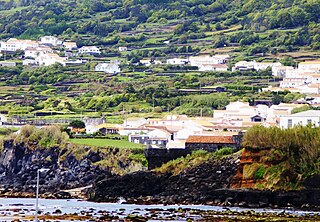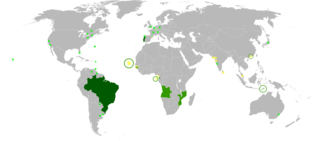
Chaves is a city and a municipality in the north of Portugal. It is 10 km south of the Spanish border and 22 km south of Verín (Spain). The population in 2011 was 41,243, in an area of 591.23 km2. The municipality is the second most populous of the district of Vila Real. With origins in the Roman civitas Aquæ Flaviæ, Chaves has developed into a regional center. The urban area has 17,535 residents (2001).

Guadalupe is a civil parish in the municipality of Santa Cruz da Graciosa, on Graciosa in the Portuguese archipelago of the Azores. The population in 2011 was 1,096, occupying an area of 20.62 square kilometres (7.96 sq mi) on the island of Graciosa.

Conceição is a freguesia in the municipality of Horta in the Portuguese Azores. The population in 2011 was 1,138, in an area of 3.08 km². It is the second smallest parish within the administration of Horta.

Lajes do Pico is a municipality in the southern part of the Azores. The municipality is located is on the southern part of the Pico Island. The population in 2011 was 4,711, in an area of 155.31 km². It is bordered by Madalena to the west and by São Roque do Pico to the north.

Feteira is a rural civil parish in the municipality of Angra do Heroísmo in the Portuguese archipelago of the Azores. The population in 2011 was 1,239, in an area of 5.25 square kilometres (2.03 sq mi).

Fajã de Cima is a civil parish in the municipality of Ponta Delgada in the Portuguese archipelago of the Azores. Fajã de Cima is located in the Picos region in the western part of the island of São Miguel, north of central Ponta Delgada. The population in 2011 was 3,438, in an area of 11.89 km².

Pilar da Bretanha is a civil parish in the municipality of Ponta Delgada on the island of São Miguel, in the Portuguese archipelago of the Azores. It was de-annexed from the historical parish of Bretanha on 10 July 2002, along with Ajuda da Bretanha. The population in 2011 was 624, in an area of 6.07 square kilometres (2.34 sq mi).

Ribeira Grande is a municipality in the northern part of the island of São Miguel in the Portuguese Azores. The population in 2011 was 32,112, in an area of 180.15 km². The municipal seat is located in the civil parish of Matriz, with a population of about 4000 inhabitants, part of the urbanized core of what is commonly referred to as the city of Ribeira Grande.

Ponta Garça is a civil parish in the municipality of Vila Franca do Campo in the Portuguese archipelago of the Azores. The population in 2011 was 3,547, in an area of 29.35 km². It is the largest parish in Vila Franca do Campo.

Água Retorta is a civil parish in the municipality of Povoação, on the island of São Miguel in the Portuguese archipelago of the Azores. The population in 2011 was 489, in an area of 12.55 km². Situated along the southeast coast, it is the smallest and most eastern parish in the municipality.

Algueirão – Mem Martins is a Portuguese civil parish, in the municipality (concelho) of Sintra. The population in 2011 was 66,250, in an area of 16.00 km². it has a population density of about 4000 inhabitants per kilometer square.

Fafe is a municipality in the northern Portuguese district of Braga.

Colares is a civil parish along the coast of the municipality of Sintra. The population in 2011 was 7,628, in an area of 33.37 square kilometres (12.88 sq mi).

The Archdiocese of São Paulo is a Latin Metropolitan Archbishopric of the Roman Catholic Church in Brazil.
Nossa Senhora do Bispo is a former civil parish in the municipality of Montemor-o-Novo, Portugal. In 2013, the parish merged into the new parish Nossa Senhora da Vila, Nossa Senhora do Bispo e Silveiras. It has an area of 121.83 km², and a population of approximately 5411 inhabitants in 2001 (approximately 44 inhabitants per km².
Lourenço José Boaventura de Almada (1758–1815), 13th Count of Avranches and 1st Count of Almada, by regal charter on 29 April 1793 to him and his descendents.

The Manor of Nossa Senhora dos Remédios, popularly known as the Manor of Remédios or Manor of the Privisioner of Arms, located in the neighbourhood of Corpo Santo, civil parish of Conceição, in the municipality of Angra do Heroísmo, in the Portuguese archipelago of Azores. It is one of the notable histo-cultural and architectural buildings in the historic centre of Angra, part of the UNESCO-classified heritage site.

Paulo António de Carvalho e Mendonça (1702–1770) was a Portuguese priest and a cardinal, a court official who served as supervisor of the house and properties of Queen Mariana Vítoria, President of the Senate of Lisbon, a Canon of Lisbon Cathedral, Grand Prior of the College of Guimarães and Inquisitor-General of the Holy Inquisition.

The Fort of Nossa Senhora das Mercês de Catalazete, also known as the Fort of Catalazete, is located on the right bank of the River Tagus estuary in the municipality of Oeiras in the Lisbon District of Portugal. The fort dates back to 1762, when a small battery was erected on a site between the Fort of São Julião da Barra and the Fort of Santo Amaro do Areeiro, with the purpose of strengthening the defence provided by those two forts.



















